Space, the final frontier for antenna installations. The ham’s ongoing mission: to explore their shrinking lot sizes and seek out smaller antennas that will keep them on the air—ones that boldly perform with the fewest compromises.
There’s nothing that says you can’t bend or wrap antenna elements to make them more compact. Think of open folded dipoles or the end droop on a wire antenna when it’s a few feet too long. Keep in mind that making a dipole smaller by wrapping it back on itself reduces not only the size but affects bandwidth as well. Regardless, this might be a good tradeoff under the right circumstances.
Another advantage is that all the antennas mentioned here resemble an outdoor clothesline to some extent. They look like they belong in the backyard, perhaps making them more acceptable to a ham’s family and the neighbors. Just make sure they don’t hang wet shirts or socks on the wires since it will negatively affect SWR.
Hexbeam
A hexbeam, or hexagonal beam, is a type of directional antenna for amateur HF bands. The name comes from the hexagonal outer shape of the antenna—not curses put upon them by HOAs. Its design resembles a modified two-element Yagi-Uda antenna, consisting of a W-shaped dipole and a reflector but no directors. The finished design looks something like an upside-down umbrella.
Hexbeams consist of six arms of non-conductive materials, such as fiberglass or plastic pipes. Insulated wire is used for the elements. In the original design by Mike Traffie, N1HXA, there were two W-shaped elements. Steve Hunt, G3TXQ (SK), later modified the design. Hunt changed the dimensions and shape of the antenna elements, resulting in an antenna which retained the original W-shaped driver, but with a semicircular reflector.
The Hexbeam can be built as a single or multiband antenna to cover different frequency ranges. Popular combinations cover 20m, 15m, and 10m (3-band) and 20m, 17m, 15m, 12m, and 10m (5-band), like DX Engineering’s XB-5 Hexx Beam. There are also eight-band models on the market. The antenna elements for the lowest frequency band are located at the exterior of the antenna, with the higher frequency bands moving inward toward the center.
Driven elements are dipoles for each band. The spacing of each element is critical because the elements of a multiband hexbeam influence each other. If the elements are not parallel, antenna characteristics may change. The spacing between the ends of the driver wires are adjusted for the best compromise between gain performance and SWR. This spacing is maintained using an insulated cord spacer between the tips of the reflector and the driver.
A hexbeam has slightly less forward gain than a two-element Yagi (5 dBi or 3 dBd) depending on the band. It beats the Yagi with front-to-back ratio across the band, reaching peaks over 20 dB. The hexbeam is also broadbanded, with the SWR comfortably under 2:1 at the band edges. For a relatively small antenna, the hexbeam holds up well against the Yagi given its size, and far exceeds the performance of multiband mini beams.
Given all these advantages, there is one minor downside. There’s more work involved assembling all those wires and spreaders than there is working with aluminum tubes. I had some hands-on experience assembling one for a display at Hamvention—and this one was a scaled-down version to fit in the booth area. It just takes some time, patience, and reading the manual prior to assembly. Real hams do read the manual. It’s worth the effort. Editor’s note: The DX Engineering XB-5 Hexx Beam (below) has been designed with fewer parts for faster and easier assembly compared with competing models.
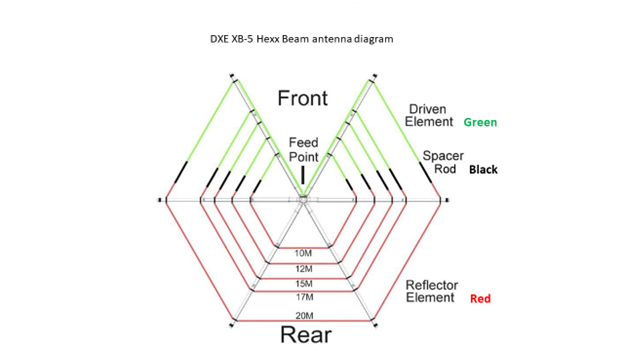
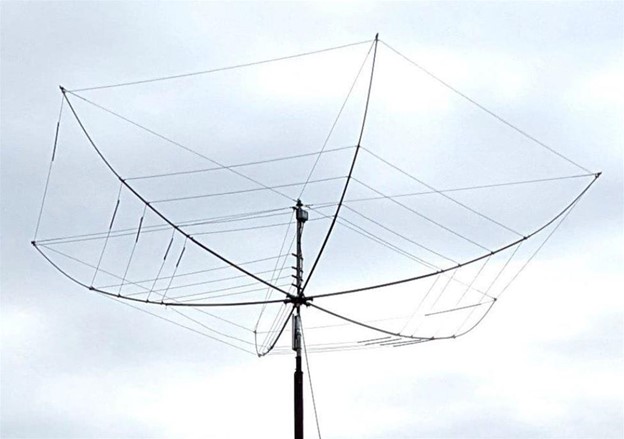
Catching Signals—The Cobweb
The cobweb was developed by G3TXQ. It was a variation of Steve Webb, G3TPW’s CobWebb antenna, consisting of concentric dipole element sections for each band that are bent into the shape of a square. The outer element is the largest and is tuned for the lowest frequency band. Elements for other bands are nested inside the larger outer loop. The feedpoints of all dipole elements are connected together and driven by a common transmission line.
The cobweb antenna is relatively small yet offers good overall performance. The below MFJ-1836H six-band version (20-6m) is easy to install in limited space, with a compact 9 x 9 footprint. It’s a lightweight structure with a low wind-loading cross-section, making it a robust antenna.
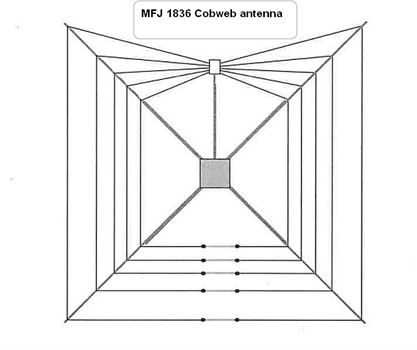
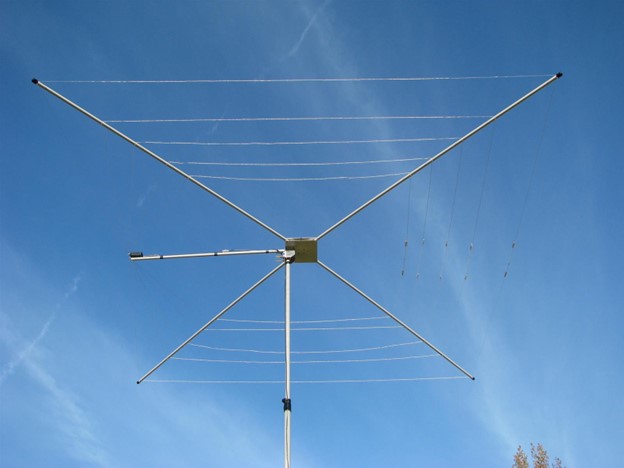
Gain is slightly lower compared to a traditional dipole (1-2 dB less peak gain), which is offset by the nearly omnidirectional pattern of the cobweb. There aren’t the deep pattern nulls off the ends you’ll see with a dipole. The bandwidth (>2:1 SWR) fully covers the 20, 17, and 12m bands but may require a tuner on parts of 10, 15, and 6m for full coverage. I’ve also noticed it has a low noise floor with less static than my other antennas.
Only one coaxial feedline is needed. To match the cobweb’s impedance of 12.5 ohms, it must be fed using a 4:1 matching transformer or balun to match it to a 50-ohm transceiver. A 1:1 balun is also needed to feed this antenna to prevent common mode currents and achieve optimal radiation. If a current balun is used, no additional choking on the coax is needed.
Cobwebs are typically fixed mounted antennas that don’t require an antenna rotator or a tall mast. You can expect reasonable performance at 10 feet, but 20 feet or more is recommended. If you want to include 30 and 40 meters, you’re in luck. The MFJ-1838 8-band version has a 12 x 12 footprint, or you can add a conversion kit to the six-band model.
Halo There
The halo antenna is commonly used for amateur radio operations. You’re probably familiar with the mobile and VHF/UHF versions. It’s a circular loop of wire that is bent into the shape of a halo or a doughnut—with a bite missing. The halo antenna is known for its omnidirectional radiation pattern, which means that it can transmit or receive signals equally well in all directions. This makes it ideal for applications where a wide coverage area is desired.
Overall, the halo antenna is a versatile and effective option for amateur radio operators looking for a compact and efficient antenna. Each half is about a quarter wavelength long and ends with a current node (zero current and peak voltage) at the break. Halos pick up less ignition noise from engines when mounted on vehicle roofs than whip antennas. They can also be stacked for additional gain and increased efficiency.
However, it’s a challenge to make a 33-foot-long folded dipole for 20 meters in a circular shape for HF use at home. But the circular shape is not necessary—a square version has almost the same properties. This antenna configuration is known as the Squalo (square and halo.) You can apply the same shape and configuration as done with the cobweb, adding additional bands. You want to add 10 meters? Make a 10-meter folded dipole and place it inside the square shape created by the 20-meter dipole.
The square halo is electrically similar to the cobweb in construction and size. If you compare the MFJ-1836 antenna to the Cushcraft ASQ-20, you’ll find both incorporate the half wave folded dipole(s) and a matching transformer. The Squalo maintains its square shape while the cobweb angles the wires to the transformer.
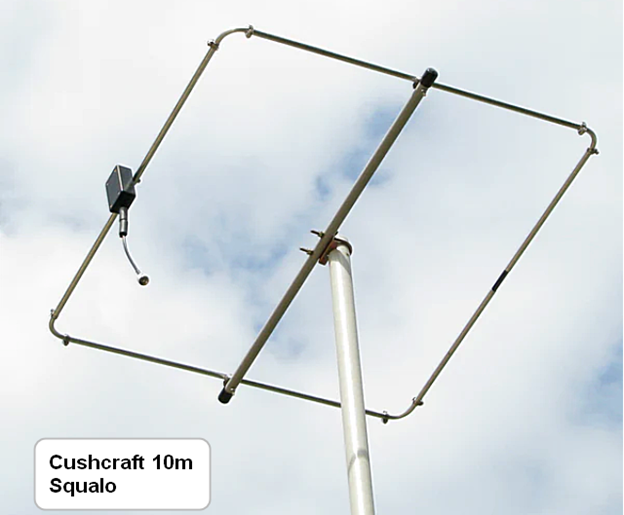
Tired of Your Plain Old Dipole?
The antenna world is full of dipole variations, and we’ve only looked at a few. If this article piqued your interest, take a look at the OnAllBands article, “Guide to Unusual Ham Radio Antennas” for a discussion of Moxon and Skeleton Slot antennas—close cousins of the halo and hexbeam.

